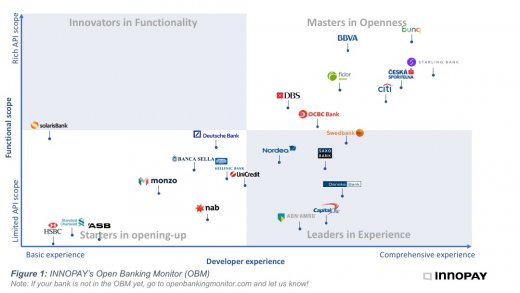INNOPAY Open Banking Monitor: Who are the Masters in Openness?
Developing state-of-the art developer portal capabilities will drive and accelerate your Open Banking strategy
Openness will become the new normal, as new regulations create the push and new technologies provide the enablers
The dawn of the Open Banking era has presumably caused some noise, especially at the more conservative banks. Indeed, banks are facing new challenges in adjusting to the new reality, as they seek to allow external third parties secure and controlled access to their customer’s resources. This development will also have profound implications on the positioning of banks in the value chain and their business- and operating model. With new regulation such as PSD2 the momentum for banks to embrace ‘openness’ and put their customers in control has increased even more. Indeed, customers will have the right to authorise third parties to connect to their payment accounts for payment initiation and account information services. GDPR is expected to further strengthen this momentum for openness and drive customer control.
Open Banking means many things to many people, but generically it refers to the concept that allows banks to share customer (data) resources with third-parties securely and in real time, through the use of open application programming interfaces (APIs). This form of data sharing will drive the creation of a partner ecosystem around the bank that serves as the catalyst for a new wave of financial innovation and experiences, new partnership opportunities and new business models.
Just like other digital businesses, banks will also need to master what relevant customer resources to expose and learn about the importance of making APIs they publish discoverable and consumable in a seamless manner. The proliferation of bank API developer portals, where third parties can access APIs, speaks to the pressure that banks are experiencing in exposing customer resources and building strategic partnerships that benefit their end customers.
INNOPAY’s Open Banking specialists observe that several progressive banks are embracing these new opportunities proactively, while others are keeping the gates closed for the time being. INNOPAY has developed a benchmark of API developer portals launched by these progressive banks. The benchmark results are visualised in figure 1 below and will be further elaborated in this article.

INNOPAY’s Open Banking specialists have used publicly available information to identify the relevant developer portals to include in the benchmark. The Open Banking Monitor assesses the developer portals of over 25 banks and provides insight in best practices to embrace openness and to connect and engage with third party developer communities. If your bank is not in the OBM yet, navigate to openbankingmonitor.com and let us know![1]
Methodology: Benchmarking developer portals and learning from the most progressive banks
Banks do not stand on the leading edge of new technology adoption and rather choose for proven technology. INNOPAY’s OBM will provide valuable information and insights in the characteristics, technology and implementation choices of the innovators in the Open Banking movement. The OBM, visualised in figure 1 above, compares several developer portals of banks on two axes:
- Functional Scope (Fs) on the y-axis: indicates the variety and richness of the functions offered by the bank's APIs. These functions are grouped into “payment” (e.g., capture payment or mandate functionalities) and “user-specific”, non-payment transaction functionality (e.g. account information and balance, personal identity attributes).
- Developer Experience (Dx) on the x-axis: provides insight on how a developer will experience the use of the banks’ developer portal and consumption of its APIs. Dx addresses questions such as: Can the developer get up to speed quickly? Is there an onboarding/registration process in place? Are there SDKs available, is a sandbox available and in what ways does the bank offer support? Are common industry standards applied, or can the developer portal be compared with a maze at best?
Findings: It’s not only the challenger banks who are setting sail
As expected the so-called “challenger banks” are in the upper right quadrant of the OBM and can be classified as “Masters in Openness”, as they are typically not hamstrung by complex, legacy infrastructures. So generally speaking, opening-up customer resources to third parties is relatively easier for these challengers. However, some incumbent banks seem to be well equipped to keep up with these agile and mobile first challengers.
Bunq and Starling are able to offer more API functionality (likely because these banks are centered around an app). Monzo has the quickest onboarding process, i.e. just an email address is sufficient to get an access token. These three banks are able to offer extra functionality such as: attach images/notes to transactions, payment chat and invoicing. While these functions do not weigh heavily in the overall rating they do add extra points to the supported functional API scope.
Bunq and Starling also excel in the Dx of their developer portal. Bunq scores high with a killer feature: an SDK within an Android Emulator. Although Bunq offers more SDK's and Formats (e.g.. PHP, C#, Java and Python), Starling still scores better as they offer more support options (e.g. email, forum and Slack) and make better use of open information security standards and practices (i.e. OAuth 2.0, Three-legged OAuth and API keys). Another differentiator of said banks is the availability of tutorials.
There are no banks in the upper left quadrant that can be qualified as "Innovators in Functionality". This can be explained from a number of factors; many banks seem to have focused on designing and publishing content in their Developer Portal over specific, rich(er) functionality of APIs. The content on these developer portals tends to be fairly static, and therefore easier to develop and deploy. The developer portal experience is an important foundational capability required to establish an interaction channel with external developers, to ensure they get acquainted with the bank, start participating in a community and feel more inclined to return as the portal and functionality of APIs mature. In contrast, adding and publishing API functionality requires solid internal review and testing before being published, as updating a specification is no trivial matter. Indeed, many banks have insider programs to review, refine and approve functionality of APIs well before they are published. As a result, it is expected that this rich(er) API functionality will lag behind the overall developer portal experience even as those APIs wait in the wings. While there is a drive to publish APIs that are required by regulation (e.g. for PSD2 compliance), banks might be more cautious to go to market with richer APIs beyond this scope and prefer to focus on improving the developer experience and common services that all APIs use.
The lower right quadrant qualifies banks as “Leaders in Experience”. It positions them on the lower end of the functional scope, but with a comprehensive Dx. The quadrant is occupied by Capital One, offering no payment APIs and three rather trivial non-payment API's (credit offers, reward points and open account). NAB offers only an account information API, while ABN AMRO’s Tikkie API is limited to payment request functionality. However, ABN AMRO indicates on its developer portal that they are currently working on some new APIs which are in beta or "coming soon" (e.g. corporate accounts is in closed beta and batch payments is coming soon).
The lower left quadrant qualifies banks as “Starters in opening-up”. HSBC, Standard Chartered and ASB qualify as such and have a minimal score on functional scope due to the lack of payment and user specific API functionality in their offering. The Dx also lags behind other banks due to the lack of support, guides, tutorials and SDK's resulting in a very basic developer portal experience with few developer-friendly features.
Solaris bank’s portal scores high on functionality, but the supporting documentation is rather limited. There is also no active registration, making it unable to get registered as a developer and thus less inviting to work with. The group of banks who are ‘stuck in the middle’ have a limited number of SDKs and support options, or they might just be getting started with their developer portals.
Get up to speed quickly with your developer portal
For banks that are about to launch their developer portal and/or a next release, some general best practices could come in handy. The OBM benchmark shows that having at least one SDK is important, and that developer guides (e.g. API usage guides, getting started) improve the overall experience while eliminating confusion for developers. Having built-in tools such as a sandbox and terminal allow developers to get up to speed quickly for testing and shows the bank’s commitment to assist developers in the best way possible. With an active support site or forum, developers tend to stick around creating and strengthening the development of a community.
There are still many banks that are not included in INNOPAY’s OBM. Navigate to openbankingmonitor.com and let us know what you are working on! These banks may be working on a developer portal internally, or they have not shown interest in it (yet). INNOPAY’s Open Banking specialists can support banks that are getting started or those that are seeking to accelerate their developer portal development. Reach out for further information.
The next update of INNOPAY’s OBM will benchmark banks that have published their PSD2 APIs and value-added APIs that go beyond the regulatory requirements.
---
[1] The following banks are not in the OBM due to various reasons; Sabadell and CA have no (or very limited) English website. Registration for Yes Bank and Wells Fargo are still pending approval, which makes assessment of their developer portal difficult at this stage. Note that the OBM is particularly addressing EU banks that are preparing for PSD2, whereas Open Banking can be embraced by every bank. The OBM will be extended over time to also provide insights in the latter category of banks.





